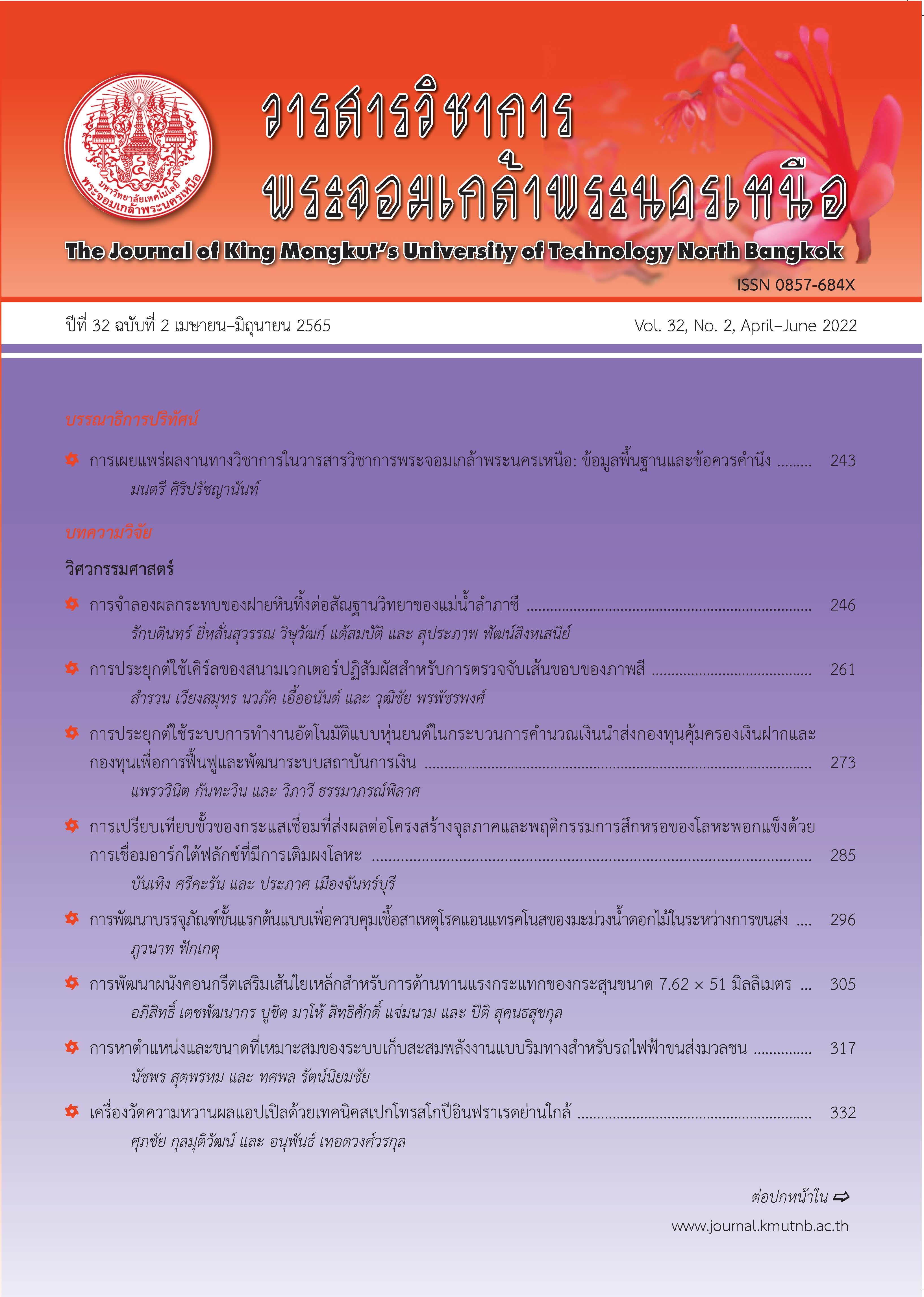สมบัติของเพคตินจากเปลือกแตงโมที่สกัดด้วยวิธีการให้ความร้อนแบบดั้งเดิมและการให้ความร้อนด้วยไมโครเวฟ
Main Article Content
บทคัดย่อ
การศึกษาสมบัติของเพคตินจากเปลือกแตงโมที่สกัดด้วยวิธีการให้ความร้อนแบบดั้งเดิมเปรียบเทียบกับการให้ความร้อนด้วยไมโครเวฟ โดยใช้กรดสำหรับการสกัด 2 ชนิด คือ กรดไฮโดรคลอริก และกรดไนตริก ความเข้มข้น 0.05 โมลาร์ อัตราส่วนของผงเปลือกแตงโมแห้งต่อกรด เท่ากับ 1:12 โดยน้ำหนักต่อปริมาตร วิธีการให้ความร้อนแบบดั้งเดิม คือ การแช่ในอ่างน้ำควบคุมอุณหภูมิแบบเขย่า ที่ 95 องศาเซลเซียส เป็นเวลา 60 นาที และการใช้ไมโครเวฟในการให้ความร้อนที่กำลังไฟ 800 วัตต์ เป็นเวลา 3 นาที พบว่า เพคตินที่สกัดด้วยกรดไฮโดรคลอริกมีค่าน้ำหนักสมมูล ระดับการเกิดเอสเทอร์ ความสามารถในการอุ้มน้ำ และความสามารถในการละลายสูงกว่าเพคตินที่สกัดด้วยกรดไนตริก การให้ความร้อนด้วยไมโครเวฟทำให้เพคตินมีน้ำหนักสมมูลและระดับการเกิดเอสเทอร์สูงขึ้น เพคตินจากเปลือกแตงโมสามารถจัดอยู่ในกลุ่ม High methoxyl pectin และเพคตินที่ได้จากการสกัดด้วยกรดไฮโดรคลอริกร่วมกับการให้ความร้อนด้วยไมโครเวฟสามารถให้ความคงตัวกับแยมสับปะรดได้ใกล้เคียงกับเพคตินทางการค้า
Article Details

อนุญาตภายใต้เงื่อนไข Creative Commons Attribution-NonCommercial-NoDerivatives 4.0 International License.
บทความที่ลงตีพิมพ์เป็นข้อคิดเห็นของผู้เขียนเท่านั้น
ผู้เขียนจะต้องเป็นผู้รับผิดชอบต่อผลทางกฎหมายใดๆ ที่อาจเกิดขึ้นจากบทความนั้น
เอกสารอ้างอิง
FAOSTAT. (2016). FAO Statistical Programme of Work. [Online]. Available: http://faostat3. fao.org
P. Kumar, “Watermelon utilization of peel waste for pickle processing,” Indian Food Packer, vol. 39, pp. 49–52, 1985.
O. Dedduang, “Comparison of extracted pectin from three kinds of guava (Psiduum guajava L.) to standard pectin,” M.S. thesis, Graduated School, Srinakharinwirot University, 2010 (in Thai).
A. Sinsopa, N. Thammawong, and A. Chantaraponpan, “Comparisons of pectin extraction methods from lime peel by conventional, subcritical water, microwave and ultrasonic methods,” in the Proceeding of 12th Mahasarakham University Research Conference, 2016 (in Thai).
P. Pornchaloempong and N. Rattanapanone. (2010). Food Network Solution [Online]. Available: http://www.foodnetworksolution.com/wiki
Z. K. Mukhiddinov, D. K. Khalikov, F. T. Abdusamiev, and C. C. Avloev, “Isolation and structural characterization of a pectin homo and ramnogalacturonan,” Talanta, vol. 53, no. 1, pp. 171–176, 2000.
B. L. Ridley, M. A. O'Neill, and D. Mohnen, “Pectins: Structure, biosynthesis, and oligogalacturoniderelated signaling,” Phytochemistry, vol. 57, no. 6, pp. 929–967, 2001.
M. L. Fishman, H. K. Chau, P. D. Hoagland, and A. T. Hotchkiss, “Microwaveassisted extraction of lime pectin,” Food Hydrocolloids, vol. 20, pp. 1170–1177, 2006.
P. Rodsamran and R. Sothornvit, “Microwave heating extraction of pectin from lime peel: Characterization and properties compared with the conventional heating method,” Food Chemistry, vol. 278, pp. 364–372, 2019.
S. Ranganna, Handbook of Analysis and Quality Control for Fruit and Vegetable Products. New Delhi: Tata McGraw-Hill Publishing Company, 1986.
S. S. Hosseini, F. Khodaiyan, M. Kazemi, and Z. Najari, “Optimization and characterization of pectin extracted from sour orange peel by ultrasound assisted method,” International Journal of Biological Macromolecules, vol. 125, pp. 621–629, 2019.
N. Bayar, M. Friji, and R. Kammoun, “Optimization of enzymatic extraction of pectin from Opuntia ficus indica cladodes after mucilage removal,” Food Chemistry, vol. 241, pp. 127–134, 2018.
U. Sanphakdee, Caffeine and catechins analysis product recovery [Online]. Available: https:// text-id.123dok.com/document/ky6xovk4ycaffeine- and-catechins-analysis-productrecovery- sanphakdee-2007.html
S. Petpirom, “Antioxidant and antimicrobial properties of pectin from monthong durian rind,” M.S. thesis (Agricultural Technology), Chanthaburi: Rambhai Barni Rajabhat University, 2017 (in Thai).
M. D. J. C. Sandarani, “A Review: Different extraction techniques of pectin,” Journal of Pharmacognosy & Natural Products, vol. 3, no. 3, pp. 142–146, 2017.
I. Hartati and E. Subekti, “Microwave assisted extraction of watermelon rind pectin,” International Journal of ChemTech Research, vol. 8, no. 11, pp. 163–170, 2015.
T. Sukkasem and K. Anukulwattana, “The optimum condition of extract pectin from cabbage (Brassica oleracea L. var. capitate) of Phu Tub Berk Amphoe Lom Kao Phetchabun Province,” Eau Heritage Journal Science and Technology, vol. 10, no. 2, pp. 262–268, 2016.
S. K. Sharma, S. J. Mulvaney, and S. S. H. Rizvi, Food Process Engineering: Theory and Laboratory Experiment. USA: A John Wiley & Sons., Publication, 2000.
P. Sirisombun, Texture Technology of Agricultural Product and Food. Bangkok: King Mongkut's Institute of Technology Ladkrabang, 2012 (in Thai).

